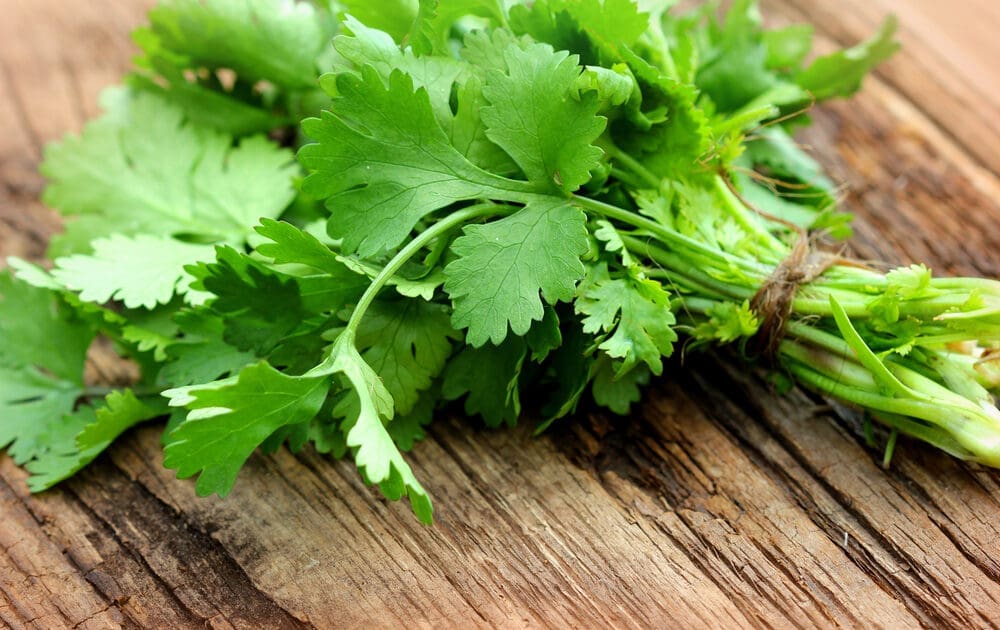Growing Cilantro (Hint: Throw Some Shade–Literally)

Do you like Tex Mex? How about Asian cuisine? If you answered yes to either of these questions, then chances are you’re a fan of cilantro. I love the fresh, fragrant herb, but I hate paying so much for a small handful at the supermarket. The solution? I grow my own, and you can too! Here are my tips and tricks for growing cilantro.
Getting to know cilantro
The first thing to know about cilantro is that it has an alias; it is also know as coriander. In the United States we refer to the gorgeous green leaves of the plant as cilantro and the seeds that form after the plant has bolted (flowered) as coriander. In the United Kingdom, however, it is more common to refer to the whole plant as coriander.
All parts of the plant are edible, but the fresh leaves and the dried seeds are the most commonly used in cooking. The leaves and seeds have individual and distinct flavors; they are not interchangeable in recipes.
Cilantro has many nutritional benefits which include, but are not limited to, being low in calories, rich in anti-oxidants, and rich in folic acid.
Not for everyone
As much as I love cilantro, I understand that it isn’t to everyone’s taste. My husband, who is a foodie with (usually) great taste, says that the herb tastes like soap. Science tells us that this taste discrepancy is due to genetics.

photo of cilantro sprouting via Shutterstock
How to grow cilantro in 6 simple steps:
I highly recommend growing cilantro from seed because it is easy and inexpensive. Although you can by cilantro seedlings from a local nursery, the following steps are for growing from seed.
Plant cilantro seeds directly in the ground once the risk of severe frost has passed. If you want to get a jump on the growing season then start them indoors on a sunny windowsill.
1. Select the growing location. Cilantro can be grown in a traditional garden, but it also grows well in a variety of containers. A shallow aluminum baking tray, ceramic pot, or window box are all good options for growing cilantro.
Cilantro likes to grow in a partially shaded area. Too much hot, direct sunlight will cause the plant to bolt more quickly. Once the plant bolts it is not useful because it’s the leaves that are most commonly used in cooking–not the flowers.
Gardeners in warmer areas can buy bolt resistant seeds, which are specifically bred for hot climates.
2. Get quality soil. Cilantro will grow well in a high quality soil, and it appreciates compost. Some gardeners look for a soil mix with added nitrogen to encourage leaf growth, but the plant isn’t too picky about having nutrients added to its soil.
3. Split the seeds. Not every gardener does this, but I swear by this tip. Hold the cilantro seeds in your hand and using your thumb nail split about half of the seeds in half. Again using you nail, scuff up (scar the surface) the other half of the seeds. This will help the tiny seeds to germinate.
4. Sprinkle seeds on the soil and cover with a couple handfuls of soil. Cilantro seeds do not need to be buried deep in the soil. Don’t worry about sowing the seeds in straight rows or obsess about their exact spacing. As long as you sprinkle the seeds evenly they’ll be fine.
5. Keep ’em damp. Cilantro appreciates a constant source of irrigation. For gardeners in warmer climates (i.e. California, Texas, and south Florida) consider placing a drip irrigation system in the garden/container where you’re growing cilantro.
For those of us in less balmy climates, keep an eye on the soil and water frequently. Don’t let the soil dry out.
6. Cilantro is a generous plant–it keeps on giving. Within ten days of sowing seeds you should see shoots emerge, and within two weeks you should be able to harvest the leaves. Use scissors to harvest the leaves and stay on top of your harvest.
Harvest all visible leaves. The plant will keep sending out new leaves so you can harvest many times from a single plant.
Good news about bugs
Here’s your daily dose of good news: Cilantro is not damaged by most insects. So (and here’s even more good news) you can employ organic growing practices in your cilantro garden and not worry about having to treat with pesticides.
And here’s another reason to grow your own and avoid the cilantro in the grocery store: Conventionally grown cilantro is probably treated with some pretty nasty chemicals. In 2011 cilantro had the dubious distinction of making its first appearance on the Environmental Working Group’s Dirty Dozen list.

image of cilantro leaves and coriander via Shutterstock
Growing cilantro is the gift that keeps on giving
Remember how I said that cilantro is a generous plant? Well, even after the plant is done producing leaves and has bolted, it will offer green coriander seeds. Wait for these small, round seeds to turn beige-brown before harvesting.
If weather demands that you harvest your coriander seeds before they have turned beige-brown, then simple pull the cilantro plant from the ground and hang it upside down in a garage or other safe space until the seeds are no longer green. Place a cloth or container under your drying cilantro to catch any dried coriander seeds that drop.
These seeds can be stored in a paper envelope and used for planting, or they can be ground and used in cooking.
One great advantage to planting the coriander seeds you harvested is that you will grow a stronger cilantro plant from them because they will be acclimatized to your growing conditions.

image of seeds in mortar and pestle via Shutterstock
Obviously, if you’re going to plant the coriander seeds, keep them whole. If you’re going to use them as a spice in recipes then grind them in a mortar and pestle and store the powder in an air tight container.
Recipes that celebrate cilantro:

image of vegan taco salad via Sara Novak
My favorite word to follow cilantro in a recipe title is lime. There’s something so appealing and refreshing about those two fresh flavors together. That’s why I love this recipe that showcases those two flavors.

image of black rice salad via Shutterstock
As much as I love salads, they can get boring. Problem solved with this salad recipe that blends avocado with citrus flavors. Yes, please!

image of raita via Andrea Nguyen
Whether you eat meatless only on Mondays or every day of the week, here are vegetarian recipes that celebrate cilantro.
Have you successfully grown cilantro? Share your tips and tricks on our Facebook page or Tweet at us @organicauthorit.
Related on Organic Authority
Growing Potatoes: 5 Proven Steps to Spectacular Spuds
How to Grow Garlic in 3 Steps for Maximum Flavor (and Vampire Prevention!)
Everything You Need to Know About Growing Tomatoes
lead image of cilantro via Shutterstock

